Check out the MP40 Reproductions from ATI on GunsAmerica (and the S&W .40 M&Ps that populate in the same search!):
https://www.gunsamerica.com/Search.aspx?T=mp40
And word on the street is that ATI has gotten approval to bring in their 9mm MP40. Until then, you can still shoot the rimfire version: https://www.americantactical.us/5008/detail.html
World War II is an iconic era in gun history, and the MP40 is, in my estimation, the 2nd most recognizable German firearm from that time period, after the Luger pistol. Anyone who has ever seen a movie or documentary will know this weapon by sight. As we look at this weapon of war, I want to be clear that I have no praise or love for the acts men and women committed through the course of that war. My intent is to look at why well over 1 million copies of this machine pistol were produced and utilized in just five years.
History
Heinrich Vollmer’s design for the MP40 was based on a simplification of the design and manufacturing process of the MP38. Both guns utilized the “blowback with advanced primer ignition (API)” system, in which the round is detonated by a blowback operated bolt/recoil system. The ignition of the primer of the 9mm round is ignited a fraction of a second before the round is completely seated in the chamber of the barrel. The result of this system is that the bolt never comes to an abrupt stop. The advantages of this are much the same as the advantages to having shocks on your car- prevention of wear-and-tear, and smoother operation.
Another change from the MP38 was the addition of a resting bar under the barrel. This was used to steady the MP40 when firing over an open-topped vehicle. Vollmer chose highly innovative materials for that era- sheet metal over machined steel, and Bakelite rather than wood. The manufacturing process itself was designed to utilize subcontracted assemblies wherever possible, and made use of stampings rather than millings, which was revolutionary in 1938.
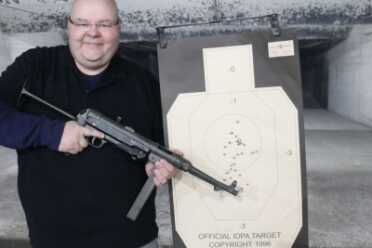
Full auto magazine dump. What was a formidable tool of war in the 1940s is still a relevant design. Too bad politics keep the original full-auto only MP40 out of reach.
Context
To fully understand the MP40 and its development choices, one must first realize that in 1938, Germany was still under the surrender terms of World War 1. The German army was not allowed to have submachine guns at all- although the German police were permitted these weapons to combat Communism. The Germans exploited this loophole by creating secret production codes for the MP40, licensing their production out to the Swiss and Belgians, who were more than willing to profit in the Germans’ secret re-arming effort.
The MP40 was designed as an intermediate weapon between the handgun and rifle, to be carried by a squad NCO’s, one per unit. However, as the war moved to the Eastern front, the Germans found themselves decimated by the Soviets’ use of submachine guns at the battle of Stalingrad. Urban conflicts such as this quickly demonstrated that the K98 rifle could not hold off entire squads of Soviet troops armed with automatic weapons. Thus, the German tactics of fielding a squad of K98 infantry men backed up by a single MG42 were adapted, and more and more infantry were armed with MP40s themselves. By the end of the war, some special units were armed entirely with MP40s.
Editor’s note: Check below for graphs that illustrate how the unit make-up changed as a result of this gun.
About Hugo Schmeisser
If you have even a cursory knowledge of the MP40, you will have heard of the name Hugo Schmeisser. You may have heard that he designed or manufactured the gun; you may have heard that he was just an urban legend and had nothing to do with the MP40. In my research, I attempted to get to the bottom of the many contradictory tales, and was able to line out some hard narrative.
Hugo Schmeisser developed the MP18- predecessor to the MP38. Hugo Schmeisser was also heavily entrenched in the German military’s manufacturing efforts, and was very influential in their decision-making processes. Schmeisser’s blowback-operated open bolt system was a game changer in submachine gun designs, and was used in several submachine guns, including the MP40. Let’s take a look at the patents that he held:
- The delayed blowback.
- The separate firing pin guided by a spring which is loose in the bolt.
- The double stack/single feed magazine system.
- A patent that was handed out on the 27th of November, 1930 to Hugo and Hans Schmeisser clearly describes a telescoping main operating spring assembly in a housing- exactly like the spring used on the MP40.
- The folding stock. Again, a revolutionary patented invention of Hugo Schmeisser. Hugo Schmeisser already applied for a patent on this invention in 1935.
So, why was Hugo Schmeisser so distanced from the MP40? From what I can tell, the driving force behind this dissociation was Erma, the company responsible for manufacturing the majority of the MP40s. Erma wanted to do business in the United States following the war, so they formed a relationship with Interarmco Ltd. to secure a United States importer. In an effort to distance themselves from the MP40s strong association with the Nazis, the folks at Erma conveniently forgot to mention that almost the design of the MP40 was based on patents from Hugo Schmeisser. Also conveniently for Erma, Hugo Schmeisser was unlucky enough to be captured by Soviets, and had succumbed to his confinement just prior to Erma entering the American market.
The Small Arms series of books claims that the only connection between Hugo Schmeisser and the MP40 was that his employer, Haenel, also produced a small number of MP40s. Hugo worked as Technical Director at Haenel. There is a rumor that the author of these books was a friend of the owner of Interarmco Ltd. One could infer that this information minimizing Hugo Schmeisser’s involvement in the development was purposely spread to help the success of the MP 40.
Innovation and Weakness
The MP 40 would not be a contender if it were released into today’s military market- it would be too big, too heavy, and too wasteful with its lack of select fire. It would also be too costly to manufacture. At the same time, the materials, construction and design of the MP40 have influenced virtually every successful submachine gun of today. I would even say that both of the most prolific rifles in production today- the AK and AR series of guns- have design and material that are direct descendants from the MP40.
[full_width]
[/full_width]
Every great gun has its weakness. The MP40’s weakness was its 32-round magazine. The single-feed insert had increased friction from the dual rows of cartridges moving upwards towards the single feed lips, this caused feeding failures, especially when dirty. Another problem was that the magazine was misused as a handhold. This caused the magazine lips to move out of the line of feed, resulting in malfunctions. In an effort to overcome these problems the German soldiers were trained to clean the magazines, and to not use the magazine as a handhold.

MP40/I Dual magazine release button on the front slides the fresh magazine into position. Photo credit: www.machinegunbooks.com.
The MP40/I
Following the harsh lessons learned on the eastern front, there was an attempt to increase the fire power of the MP40, and the MP40/I was born. The primary difference is the massive magazine holder that offers room for 2 magazines. The top part of the new magazine holder is a rail for the lower part. The lower part holds two magazines. After firing the first magazine, you push the release button on the front and slide the fresh magazine into position. The magazine release is on the rear of the magazine holder itself. Pretty neat!
Accessories
German guns are known for accessories that are numerous, functional and expensive. The MP40 is no exception to this rule. Beyond the usual items such as magazines, pouches and cleaning gear, there are some unexpected selections. I have come across the following in my research: magazine loader, blank firing device, winter trigger muzzle protector, MP transportation box, magazine cleaning brush, firing pin gauge, safety strap, protection cover, sound suppressor, spare parts box, and carrying sling.
[one_half]
[/one_half][one_half_last]
[/one_half_last]
On the Range
The MP40 that I tested is owned by a friend of mine, who has it available for rental at his indoor gun range https://www.sturmsrange.com/ . I actually brokered the deal in which he acquired this gun a number of years ago. From what I can discern by researching the markings on the gun, this MP40 was made by Erma in 1941. The gun was Parkerized at some point in its life, and that finish is beginning to show the last 20 years of wear.
The gun came with two magazines, and what I believe to be an aftermarket loader. One of the magazines will run flawlessly, but the other requires some manipulation in the well. Prior to shooting this 75-year-old piece of history, I stripped the gun down and inspected and lightly oiled a few of the components.
The first thing that I was shocked by when I stepped onto the range was the incredibly smooth trigger pull. I did not have my trigger pull gauge with me, but I would estimate that it was no more than 3 ½ pounds. It was a traditional long German trigger pull, similar to what you would expect on an MP5. The last time I had shot this gun it was remarkably easy to control, and this outing was no exception. The recoil was highly manageable, and the muzzle climb was as minimal as I’ve ever experienced from a submachine gun. With careful trigger control I could squeeze one, two, three and four round bursts off at will.
One of the standard tests that I like to run on all machine guns is to do a full mag dump and determine how many rounds remained on target. The MP40 was so controllable that I was able to place every shot on target, with all but a few in the 0 Down Cir. of the IDPA target I was using. I decided to try a little accuracy trial next, but it was proving a little difficult to squeeze off one shot while focusing primarily on precise trigger control. This resulted in two, and sometimes three shot bursts. However, even without the option of semi auto fire, this old war horse delivered exceptionally well overall.
The only malfunctions I experienced were due to the finicky magazine not being inserted and held correctly in the gun. Other than that, the gun ran smoothly. The MP40 is certainly a gun I recommend trying out, if you have the chance to shoot one.
The Future? Or a Remnant of History?
The answer to this question is clearly: Yes! Almost every submachine gun owes something in its lineage to the MP40. With the news of the ATF approval of the American Tactical Imports update, I think the MP40 semi-auto pistol is also in our future. I would love the opportunity to test the ATI MP40 pistol against the original. Until then, I will have to make do with the regular visits to my good friends at Sturm’s to get my fix.
[full_width]
[/full_width]
[one_half]
[/one_half]
[one_half_last]
[/one_half_last]
[one_half]
[/one_half][one_half_last]
[/one_half_last]
[one_half]
[/one_half][one_half_last]
[/one_half_last]
[full_width]
[/full_width]
[one_half]
[/one_half][one_half_last]
[/one_half_last]
[one_half]
[/one_half][one_half_last]
[/one_half_last]
[one_half]
[/one_half][one_half_last]
[/one_half_last]
[one_half]
[/one_half][one_half_last]
[/one_half_last]
[one_half]
[/one_half][one_half_last]
[/one_half_last]
[full_width]
[/full_width]
[one_half]
[/one_half][one_half_last]
[/one_half_last]
[one_half]
[/one_half][one_half_last]
[/one_half_last]
[one_half]
[/one_half][one_half_last]
[/one_half_last]
[one_half]
[/one_half][one_half_last]
[/one_half_last]
[one_half]
[/one_half][one_half_last]
[/one_half_last]
[one_half]
[/one_half][one_half_last]
[/one_half_last]
[one_half]
[/one_half][one_half_last]
[/one_half_last]
[one_half]
[/one_half][one_half_last]
[/one_half_last]
[one_half]
[/one_half][one_half_last]
[/one_half_last]
[one_half]
[/one_half][one_half_last]
[/one_half_last]
[full_width]
[/full_width]
[full_width]
[/full_width]
[full_width]
[/full_width]
[full_width]
[/full_width]
[full_width]
[/full_width]
[full_width]

MP40 complete in shipping create Winter Trigger Magazine loader Sling cleaning gear. h/t www.simpsonltd.com.
[/full_width]
[full_width]
[/full_width]
[full_width]

Release button on the front slides the fresh magazine into position. Photo credit: www.machinegunbooks.com.
[/full_width]
[full_width]

instruction sheet showing how to keep gun running and use of safety strap. Supplement to h.b.Bl.1941 part C Nr. 985
[/full_width]




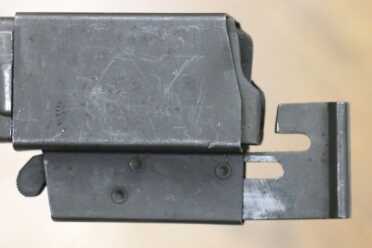


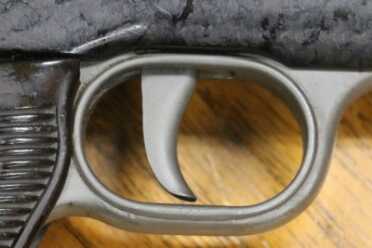


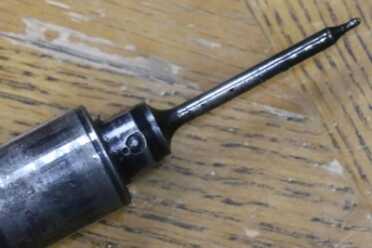

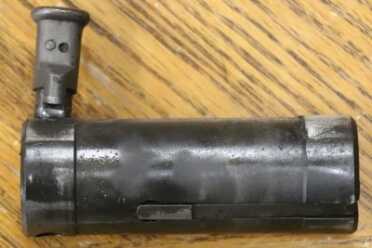
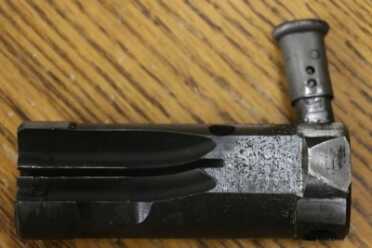
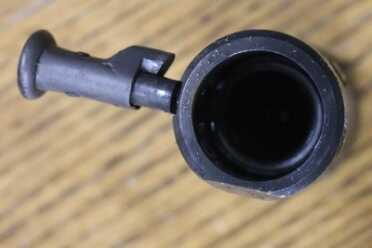
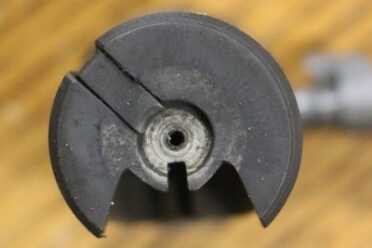
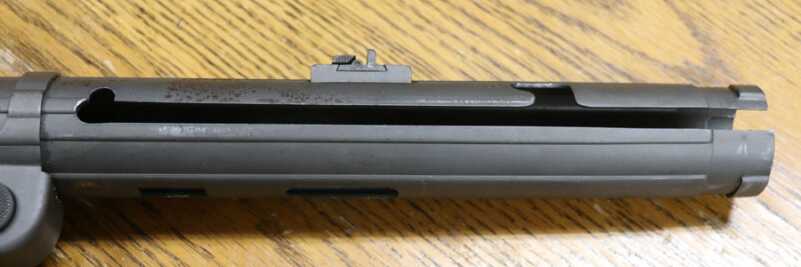

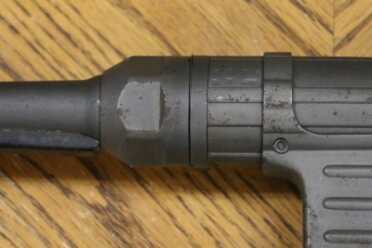
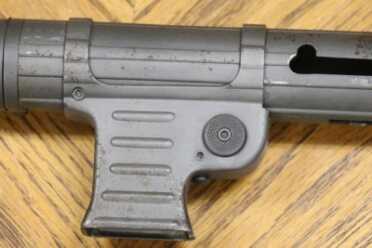
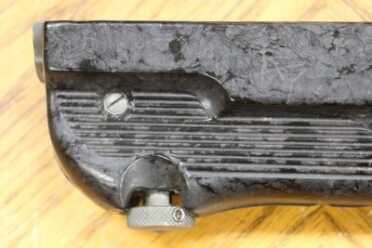
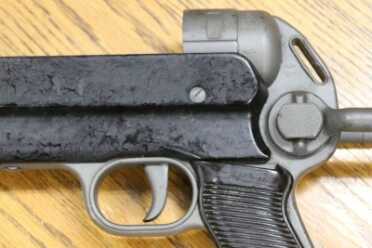
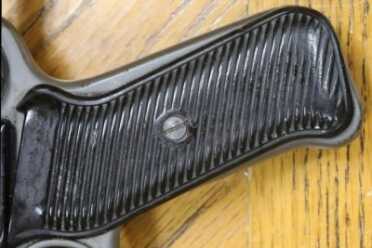
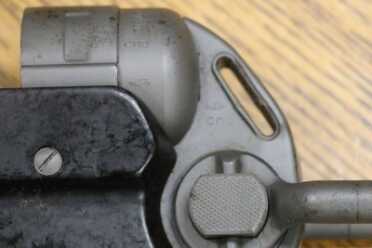
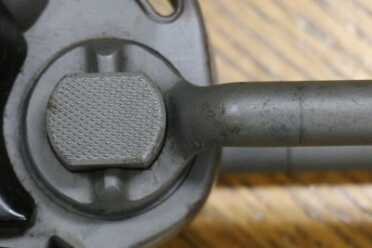
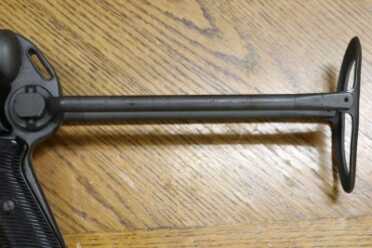
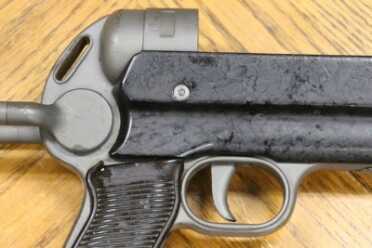
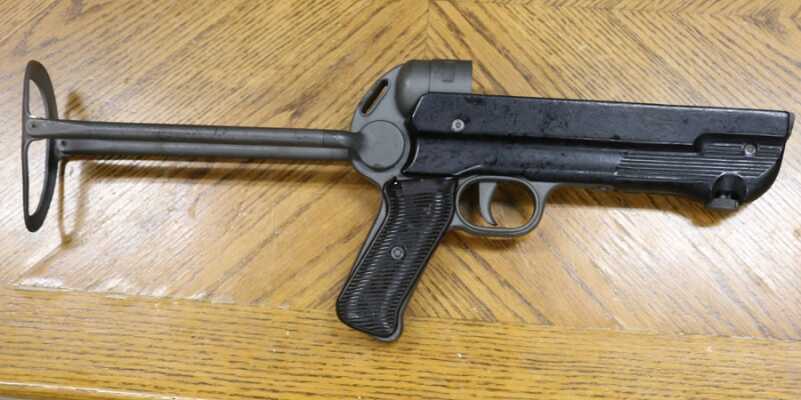

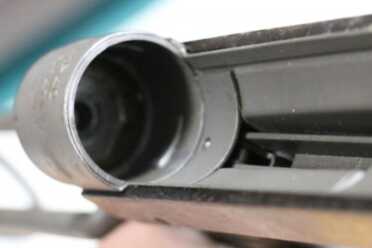
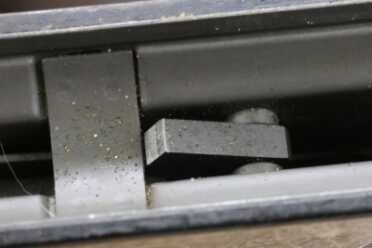
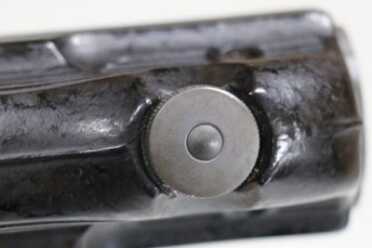
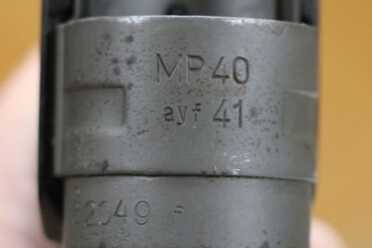
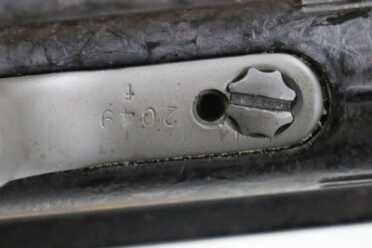
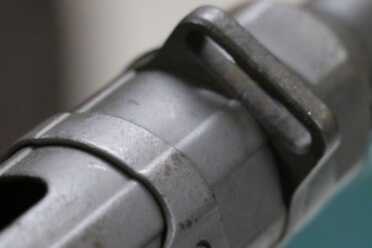
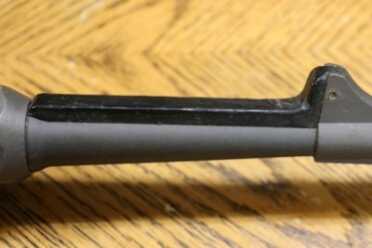
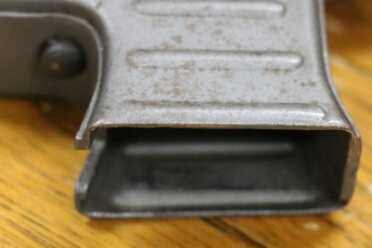
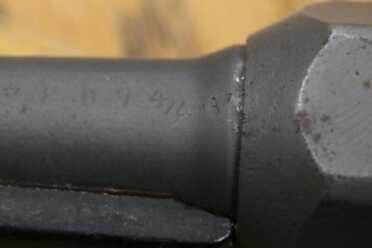
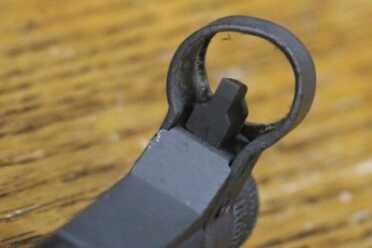
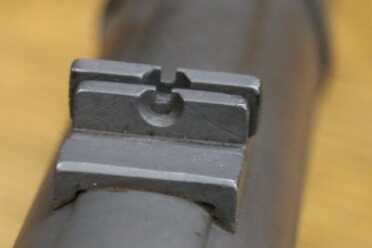
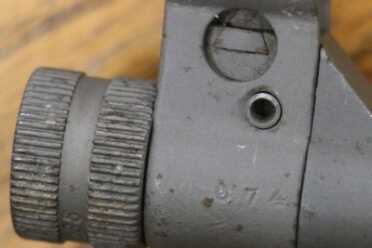
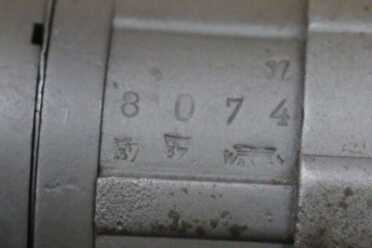
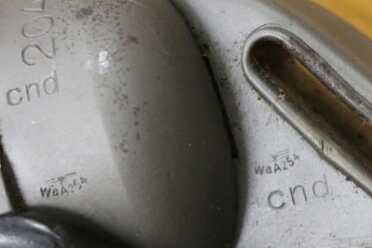

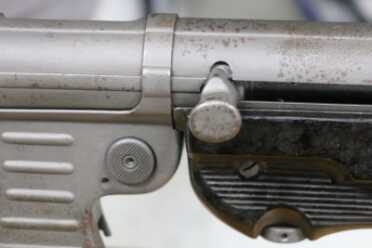
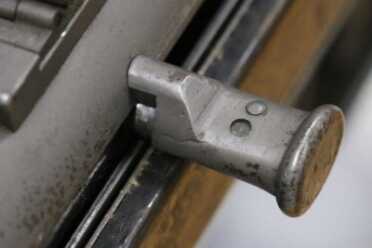

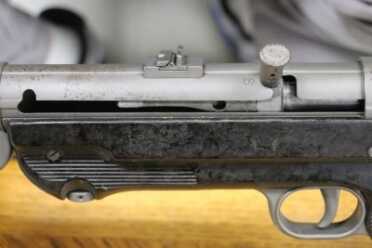
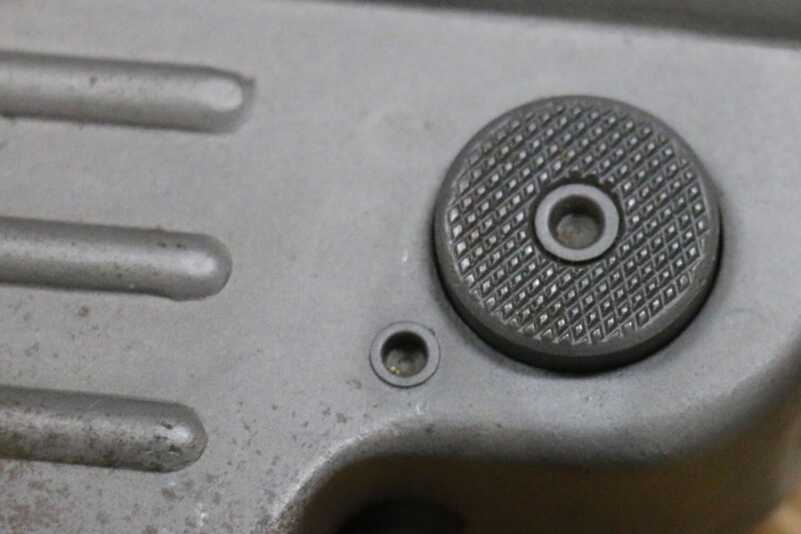


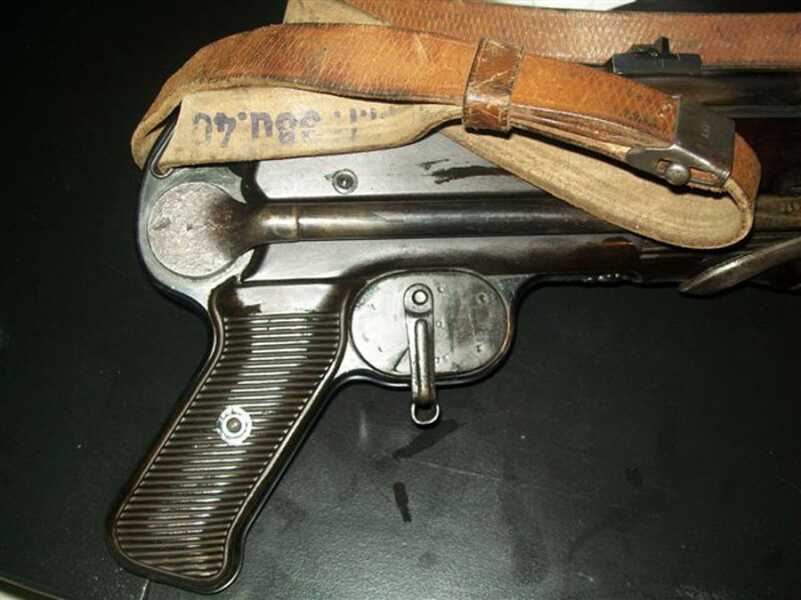
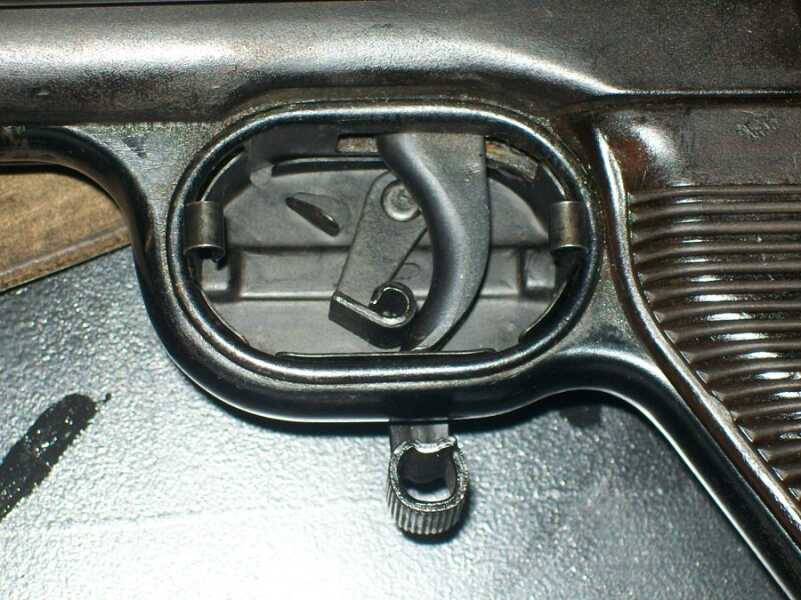
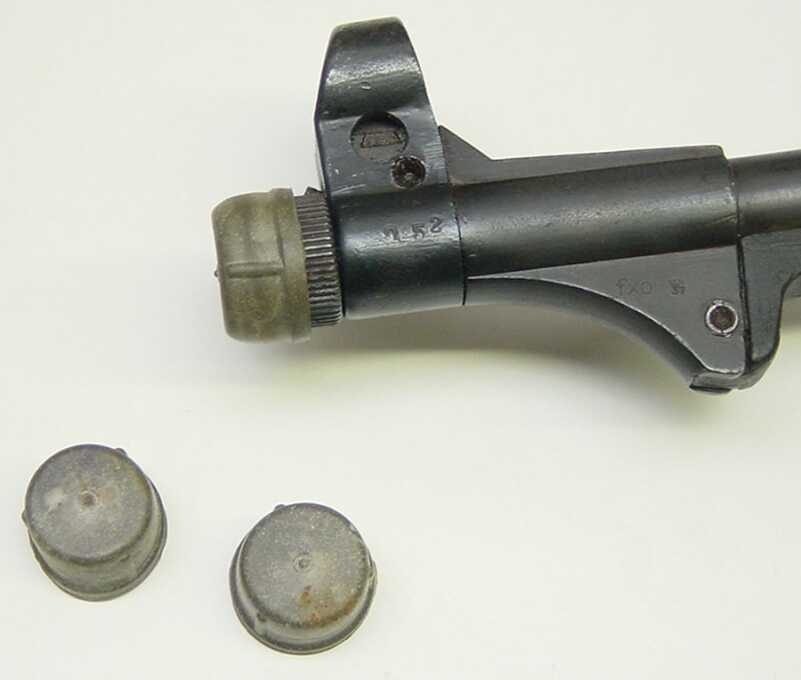
Look how wide that Front Sight is, in the above photo.
Definitely designed for short range, quick target aquisition (wack-a-mole shooting).
IOWs, aiming at & hitting the enemy’s torso; not his coat button !
I own an MP 38 and 7 MP 40s – 4 original and 3 “new tube” guns that I shoot. The originals are 40, 41, 42 u. 43. I am always looking for 44 and a 45 dated guns to complete the set. Of course I’d also like to have a 38 u. 39 dated MP 38s to go with my 1940. Some day – Maby???
The MP 40 is a dream to shoot and it takes very little practice to be able to double or single shot it.
Don’t see any way to post photos here or I’d show the heard.
Sarge
You are truly an enviable man. The MP40 is in my top 5 list of historical dream guns. As much as I’m glad to see a modern remanufacturing of it (and the lower price-point that goes with it), the semi-auto limitation almost makes it too painfully unauthentic to bother buying.
I’d love to see your collection. Don’t know if comments are forbidden from containing links, but if you create an account on imgur.com, you can upload pictures, then give us your imgur user name and we can find the pics easily enough.
I’m lucky enough to have a 100% stock MP40, with all matching numbers, 7 magazines, an original magazine pouch for 3 mags., an original mag. loading tool and original black carrying strap. The unit’s rear frame is stamped bnz 41. The original blue finish is approx. 75% and the bore is still very shiny. I fire at least one magazine of 9mm ammo through the weapon about once a year just for the thrill of it. Yes it is VERY pleasant to fire and very accurate. Several years ago I bought a spare MP40 bolt and recoil spring assembly to install and use in the once a year firing sessions. I remove the original bolt and spring assembly before I fire the weapon and replace them with the spares. The “cooling” bar under the barrel is aluminum construction and is proof marked. The right grip panel is cracked so I removed both panels to prevent any more damage. I bought an after market set of black aluminum grip panels and installed them on the unit to preserve the original panels. The MP40 in my estimation was ahead of it time in may ways and will remain one of my most treasured pieces of my collection.
My collection also includes a German MP41 sub gun and a British Sten gun, both of which I fire when I limber up the MP 40. As far as I’m concerned the MP40 is the superior weapon.
Cariins
The MP-40 is very ergonomic and has a usable cycle rate.Points shoots great. I wouldn’t trade 2 for 1 Thompson 1928
Great article Any bad guy is a goon or a gook !
A “gook” is an enemy Asian soldier. NK: gook. SK: not gook.
I take offense to the author’s reference to the picture of the German soldier as a “German infantry goon”. If the image is in fact of an infantry soldier, what arbitrarily makes that individual a goon?
I agree if he was a German soldier he was not a goon he was a soldier fighting for his country and for the people of this country not every German soldier was A Nazi.
If you disobeyed an order, you’d be shot. Simple. Even refusing to swear personal loyalty to Hitler would have gotten you disgraced & killed. It’s illogical & unfair to call a German soldier “a goon” the author is an idiot.
My dad carried a captured MP-40 in Vietnam.
A question (trivia) I always ask my students (firearms examiners):
There is a little bump on the underside of the barrel, opposite to the front sight and approximately couple of inches to the rear of that front sight.
What is a purpose of this bump????????
I know, do you ??????
I was taught that while it was fired through and armored vehicle’s firing-port, the bump was to prevent recoil from forcing the barrel back into the vehicle and causing a bit of a distraction inside the vehicle. Having fired other automatic weapons, the reasoning sounded logical. After firing an MP-40, however, I doubt that reasoning because the recoil of the 9mm is so totally absorbed by the weight of the piece, that there is virtually no recoil. It is the sweetest automatic I have ever had the pleasure to hold in my hands. Of course, in 34 years in foreign military sales, I never met a weapon system I didn’t love, but the little MP is sooo schweet!!! US Army (Ret)
the grip on that mp40 has a problem, its not correct. the other pics show say the winter trigger system show how it is correct.
I wonder what the re-cycling rate is?
I would love to have the complete package with shipping box 5 mags and all the gear, what a seriously well designed timeless piece!
I own two of the new semi-auto only (22 caliber) MP-40’s – the quality is nothing less than perfection!
I’ve always wanted to own one of these fine looking firearms as far back as I could remember watching the Rat Patrol’ Combat the TV series and of course the movie “Where Eagles Dare”. I used to listen to my grandfather talk about WW2 and when he hit the beach at Anzio’ how much our own troops wanted a captured MP-40′ he also told me he witnessed the U.S. Navy dumping hundreds of MP-40’s and other weapons off the ship into the ocean of captured weapons being brought back by American GI’s…………………..Needless to say it broke my heart to hear of such fate of so many quality firearms.
7 years ago I had an opportunity to shoot an MP40 and found it would misfeed every 5 or 7 rounds. Did not know until now that holding it by the magazine would induce the problem. Great write up. Thanks.
When I was a younger man almost a half century ago, I had the privilege to own a 1941 Haenel for a short time. I grew up post WWII building a desire to own one precisely because of Hollywood. If it was good enough for Frank Sinatra in Von Ryan’s Express, it was a “must have” firearm. Mine had an amazing quality blued finish and unlike the author’s example, the barrel guard was made out of aluminum instead of plastic, but even that small piece had an inspector’s proof stamp. It is incredibly easy to take down. The knurled nut underneath was spring tensioned. Just pull it out and twist it and the the major components came apart. Loads easier to take down than an M16, but it was surprisingly heavy. If memory serves, we are talking M1 Grand heavy. It was all I thought it would be and a breeze to shoot. With the weight, there was virtually no muzzle climb. Back then I had to lay out $600 for it (quite a lot back then), but considering that today they go for $20k – $25k, I guess it was a bargain.